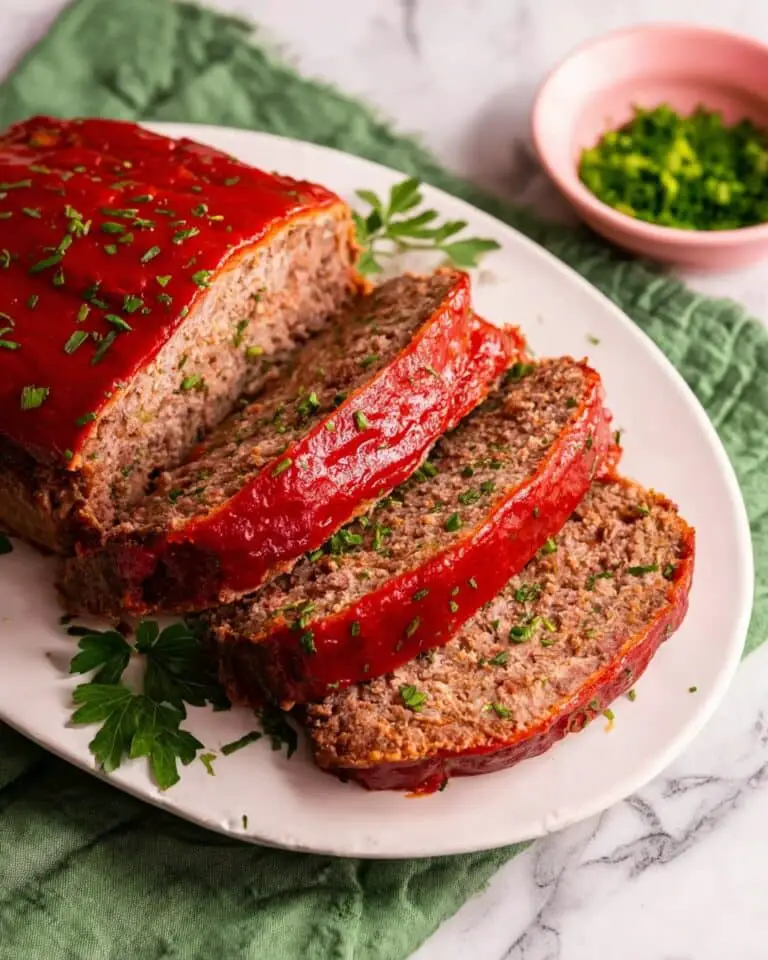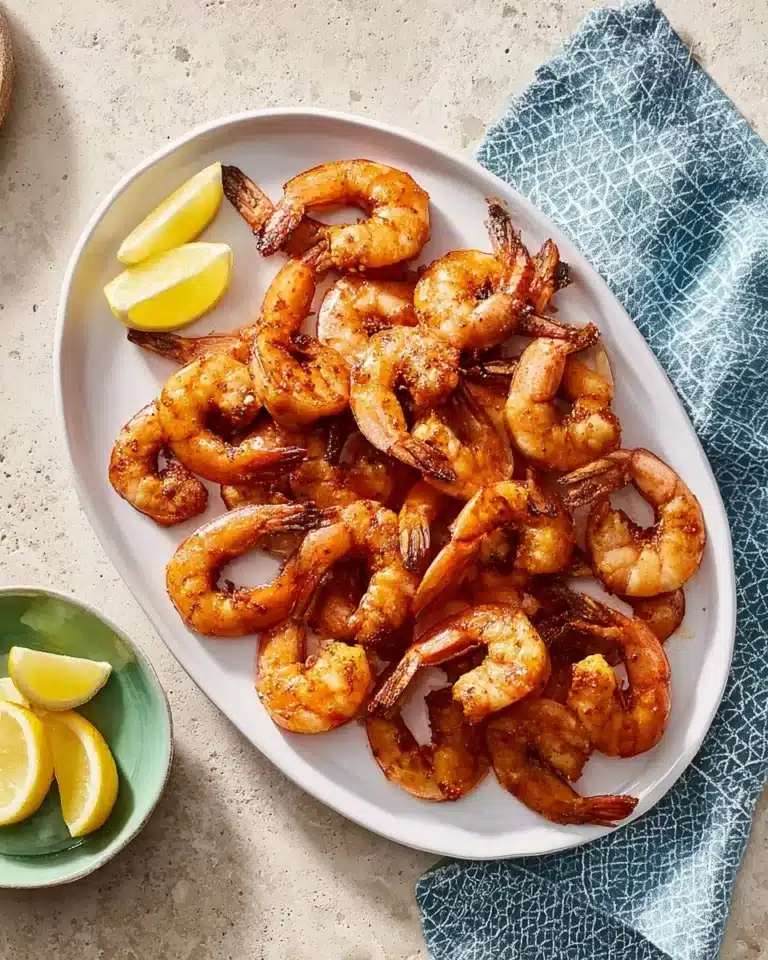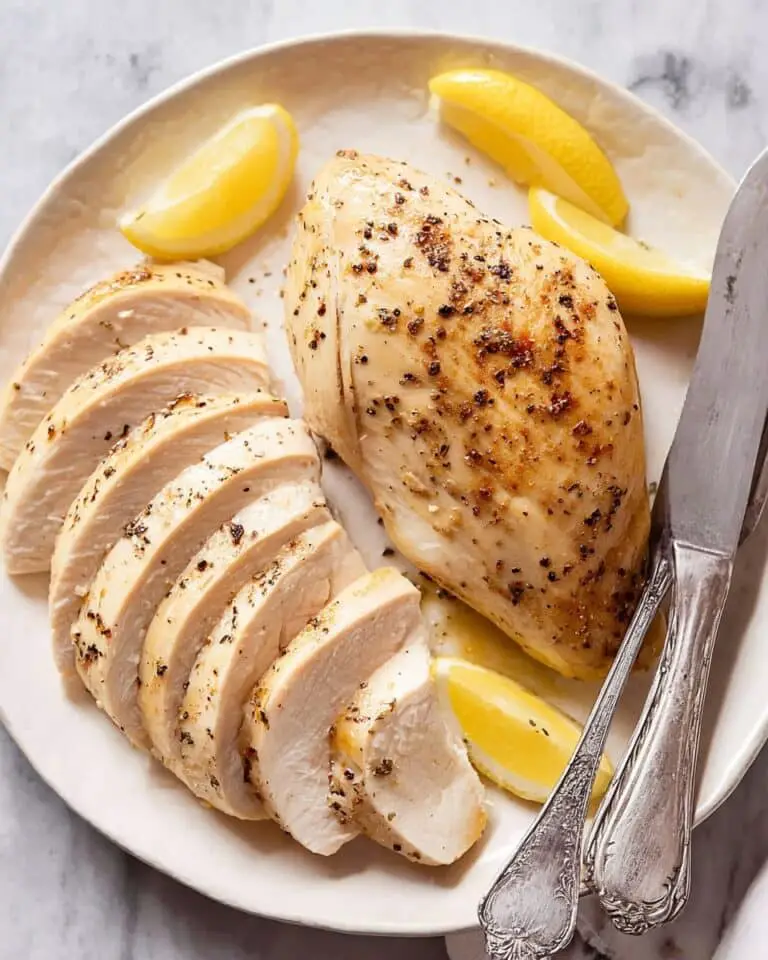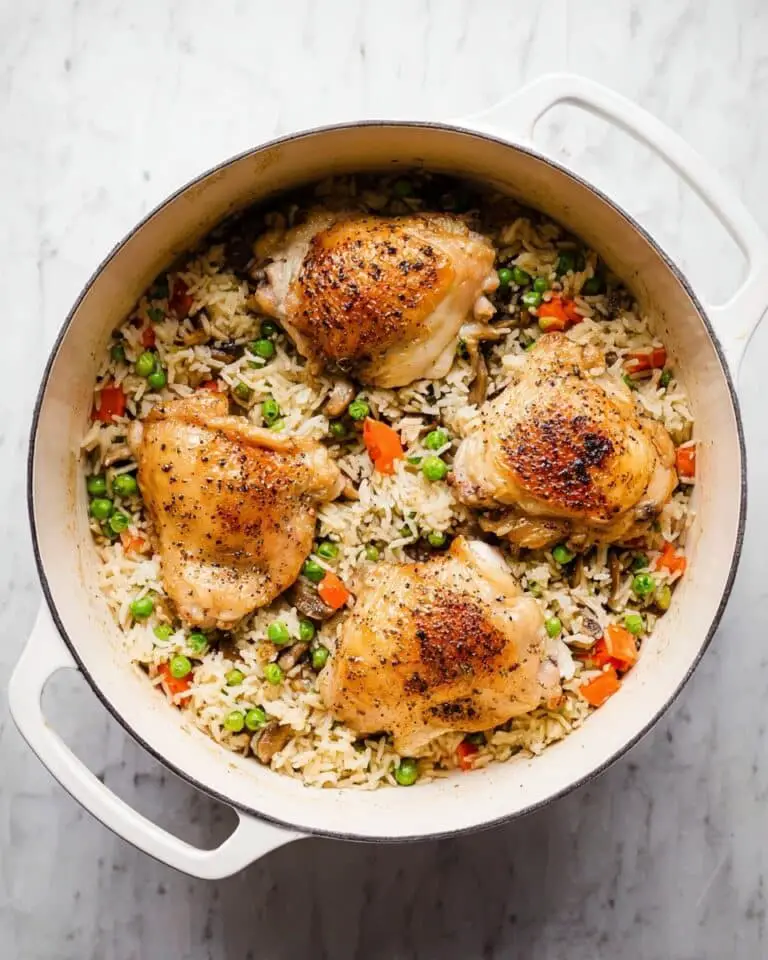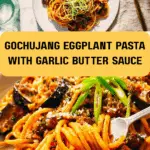If you are craving a dish that effortlessly combines bold Korean flavors with comforting Italian pasta, this Gochujang Pasta with Eggplant Recipe is about to become your new obsession. Picture tender eggplant bites caramelized to perfection, enveloped in a luscious, slightly spicy gochujang-infused sauce that beautifully coats every strand of linguine. Creamy Parmesan adds a hint of richness while scallions bring fresh brightness, making this a harmonious fusion that’s as exciting as it is satisfying. Whether you’re cooking for yourself or sharing with a friend, this recipe delivers flavor-packed magic in just 25 minutes.
Ingredients You’ll Need
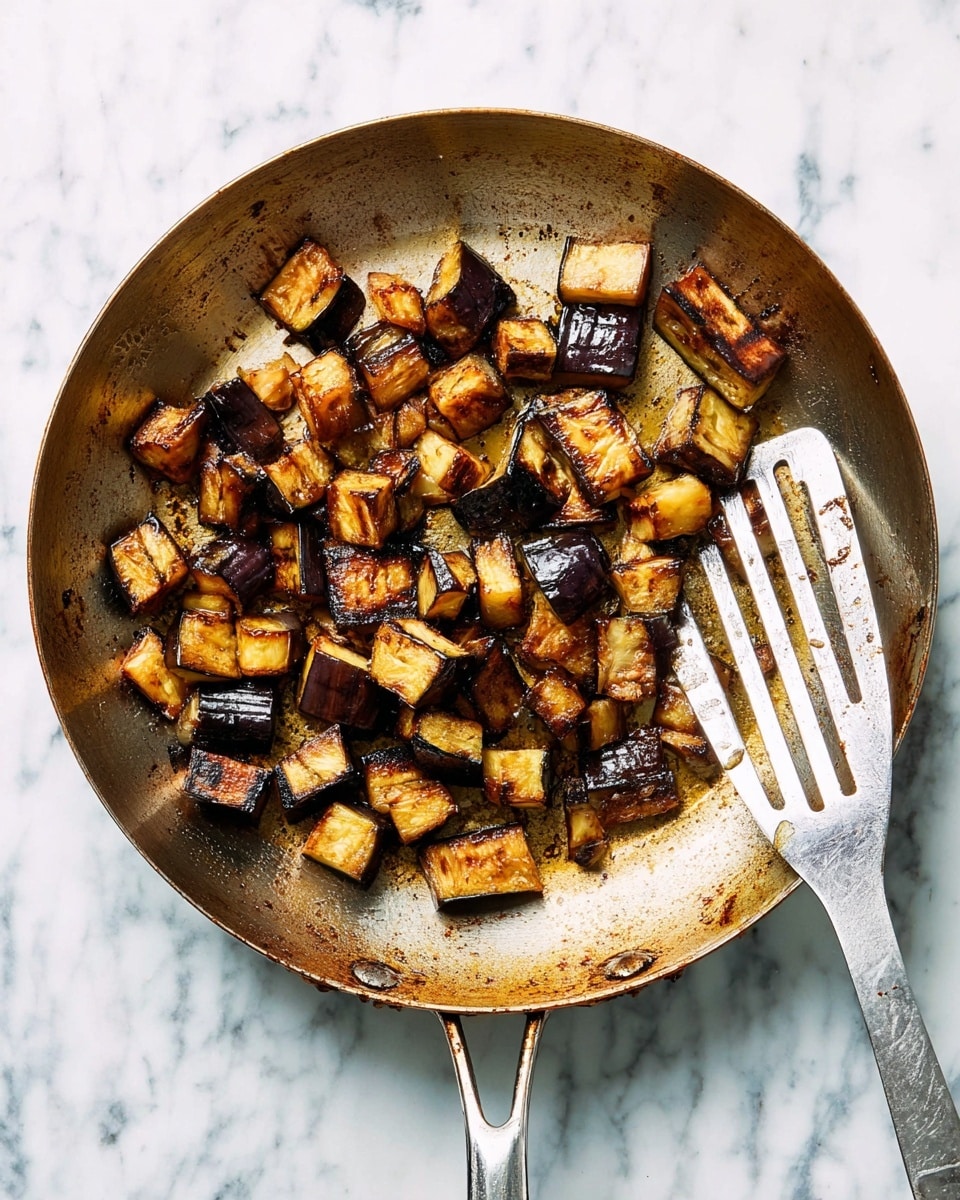
The beauty of this recipe lies in its simplicity—each ingredient plays an essential role, from the tender eggplant’s meaty texture to the vibrant kick of gochujang paste that brings everything alive. Here’s what you’ll gather to create this unforgettable dish.
- 1 lb eggplant: The star vegetable, offering a silky texture that soaks up all the flavors beautifully.
- 1¼ teaspoon fine sea salt: Divided use; crucial for drawing out moisture and seasoning perfectly.
- 1 tablespoon grapeseed oil: A neutral oil ideal for getting the eggplant crispy without overpowering the flavors.
- 1 tablespoon tamari: Adds deep umami while keeping it gluten-free (can be swapped with soy sauce).
- 1 teaspoon toasted sesame oil: Imparts that irresistible nutty aroma and complexity to the cooked eggplant.
- 3 scallions (green onions): Their subtle onion flavor layers freshness into both the sauce and garnish.
- 6 oz dried linguine: Or spaghetti works just as well; pasta that holds the sauce so wonderfully.
- 3 tablespoons butter: Creates a rich, silky sauce base (vegan butter works great too!).
- 2 cloves minced garlic: Essential for fragrant depth and a touch of mellow heat.
- 4 teaspoons gochujang paste: The fiery, tangy Korean fermented chili paste that defines this recipe’s bold character.
- ¼ cup finely grated Parmesan cheese: Adds creamy saltiness and balances the spice perfectly (can use vegan cheese).
- Crispy onions and/or scallion curls: Optional garnish for extra texture and sharpness.
How to Make Gochujang Pasta with Eggplant Recipe
Step 1: Prep the Scallions
Start by thinly slicing the scallions, carefully separating the white and light green parts from the dark green tops. The lighter parts will lend their gentle sweetness to the sauce during cooking, while the dark green curls will be reserved for a fresh, crunchy finish that brightens the dish’s flavor.
Step 2: Prep the Eggplant
Chop your eggplant into hearty bite-sized chunks. Then soak it in a bowl of cold salted water with a weighted smaller bowl on top to keep the eggplant submerged. This step is key to drawing out excess bitterness and moisture, ensuring the ultimate tender yet caramelized pieces once cooked.
Step 3: Cook the Eggplant
Heat your skillet until it’s properly hot, then swirl in grapeseed oil. Lay the eggplant in a single layer, sprinkling with salt again to season. Cooking it until it is golden brown on all sides gives you that perfect contrast—crispy on the outside with a melt-in-your-mouth interior. Finish by tossing the warm eggplant with tamari and toasted sesame oil to infuse it with deep umami and nutty notes.
Step 4: Cook the Pasta
While the eggplant is working its magic, bring a large pot of salted water to a boil and cook your linguine until al dente. Don’t forget to reserve a cup of the starchy pasta water—that ingredient is pure gold for creating a silky sauce consistency later on!
Step 5: Build the Sauce and Finish
Let your skillet cool a little to protect the butter from burning, then melt the butter on low heat. Add your minced garlic and the white and light green scallion parts, cooking until the garlic just starts to turn golden and fragrant. Next, stir in the gochujang paste along with two-thirds of the reserved pasta water, whisking until you get a smooth, spicy sauce. Finally, toss the cooked pasta and golden eggplant into this flavorful mixture, sprinkle with Parmesan and scallion greens, and add more pasta water as needed to achieve a glossy, luscious coating.
How to Serve Gochujang Pasta with Eggplant Recipe
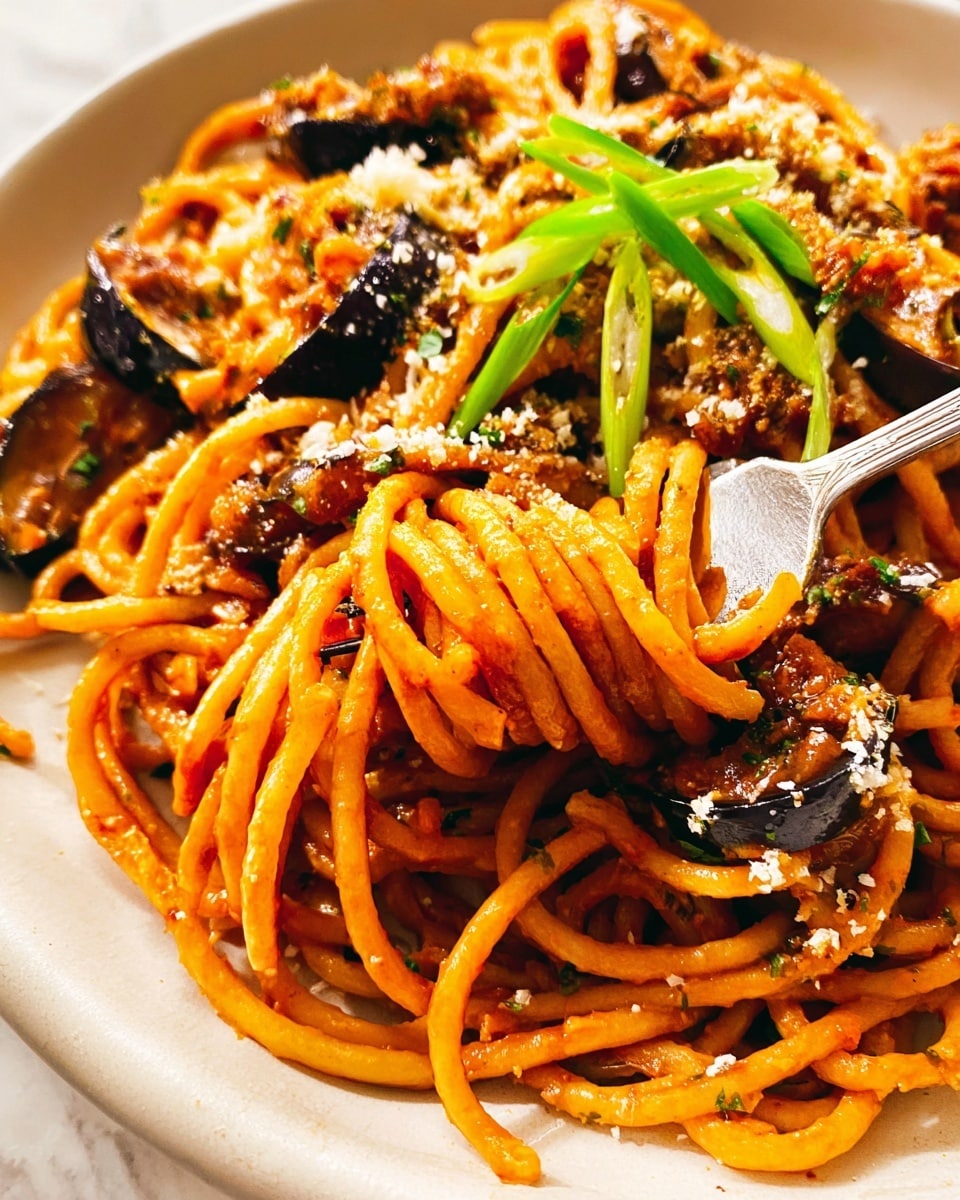
Garnishes
To really elevate the presentation and add pops of flavor, scatter crispy onions or scallion curls on top just before serving. They bring an irresistible crunch and burst of freshness that perfectly contrasts the rich, spicy pasta.
Side Dishes
This recipe is wonderfully bold on its own, but if you want to round out your meal, a bright Asian-inspired cucumber salad or a simple side of steamed greens like bok choy or broccoli makes for a refreshing foil to the pasta’s richness.
Creative Ways to Present
Try plating the pasta in shallow bowls and topping with extra parmesan shavings and a drizzle of toasted sesame oil for a glossy finish. You can also serve it family-style with vibrant garnishes in bowls on the side, letting everyone customize their plates. The striking red sauce and deep golden eggplant always make a gorgeous visual.
Make Ahead and Storage
Storing Leftovers
If you have any leftovers of this Gochujang Pasta with Eggplant Recipe, pop them into an airtight container and refrigerate. It will stay fresh for about 2 to 3 days and the flavors tend to deepen overnight, making for an even more delicious second helping.
Freezing
While you can freeze the pasta, keep in mind that the eggplant’s texture might soften further once thawed. For best results, freeze cooked pasta and sauce separately when possible, then gently reheat together to maintain the texture and flavor balance.
Reheating
Gently rewarm your leftovers in a skillet over low heat, adding a splash of water or broth to loosen the sauce as it warms. Avoid using a microwave if you want to maintain that silky sauce texture and avoid drying out the eggplant pieces.
FAQs
Can I use another type of pasta instead of linguine?
Absolutely! Spaghetti, fettuccine, or even penne can work well with the sauce. Just choose a pasta that can hold the sauce nicely for an equally delicious experience.
Is gochujang paste very spicy?
Gochujang has a moderate heat level paired with a sweet and savory depth. If you’re sensitive to spice, start with a smaller amount and adjust to taste. It provides more than just heat—it adds complexity to the dish.
Can I make this recipe vegan?
Yes! Swap the butter for a plant-based option and use vegan Parmesan or nutritional yeast. This way, you keep the creamy, rich elements without dairy, while maintaining the recipe’s incredible flavor.
Why do I soak eggplant in salt water?
Soaking the eggplant helps remove bitterness and excess moisture, resulting in a firmer texture that crisps up nicely when cooked. This technique makes a big difference in flavor and mouthfeel.
Can I substitute tamari with soy sauce?
Definitely. Tamari is a gluten-free soy sauce alternative with a slightly richer taste, but regular soy sauce works well if gluten is not a concern. Just be mindful of the saltiness and adjust accordingly.
Final Thoughts
Trying this Gochujang Pasta with Eggplant Recipe will open the door to a truly exciting culinary adventure blending the best of Korean and Italian flavors. Whether you’re a pasta lover or a fan of bold spice, this dish promises satisfaction with every bite. So why wait? Grab those ingredients and treat yourself to something deliciously different tonight!
Print
Gochujang Pasta with Eggplant Recipe
- Total Time: 25 minutes
- Yield: 2 servings
- Diet: Vegetarian
Description
A vibrant and comforting Gochujang Pasta with tender, golden-browned eggplant, tossed in a savory-spicy gochujang butter sauce and finished with scallions, Parmesan, and crispy onion garnish. This quick 25-minute recipe delivers Korean-inspired flavors with an Italian pasta twist, perfect for a delicious weeknight meal.
Ingredients
Eggplant Preparation
- 1 lb eggplant, chopped into 1-inch pieces
- 1¼ teaspoon fine sea salt, divided use
- 3 cups cold water (for soaking eggplant)
Cooking and Sauce
- 1 tablespoon grapeseed oil (or other neutral oil)
- 1 tablespoon tamari (or soy sauce)
- 1 teaspoon toasted sesame oil
- 3 scallions (green onions), thinly sliced, separated into white/light green and dark green parts
- 6 oz dried linguine (or spaghetti)
- 3 tablespoons butter (vegan butter if needed)
- 2 cloves garlic, minced
- 4 teaspoons gochujang paste (not sauce)
Finishing and Garnish
- ¼ cup finely grated Parmesan cheese (vegan alternative if needed)
- Crispy onions and/or scallion curls for garnish
Instructions
- Prep Scallions: Thinly slice the scallions and separate the white and light green parts for cooking, reserving the dark green parts for garnish.
- Prep Eggplant: Chop the eggplant into 1-inch bite-sized pieces. In a medium bowl, mix 3 cups cold water with 1 teaspoon salt. Submerge the eggplant pieces in this salted water, using a smaller bowl to keep them submerged. Let sit for 10 minutes, then drain and pat dry.
- Cook Eggplant: Heat a large stainless steel skillet over medium-high heat until a flicked water droplet bounces and skids. Add 1 tablespoon grapeseed oil and spread the eggplant in a single layer. Sprinkle the remaining ¼ teaspoon salt over the eggplant. Cook, stirring occasionally, until all sides are golden brown, about 8 to 10 minutes. Adjust heat and add oil if sticking occurs. Remove from skillet and toss with tamari and toasted sesame oil. Set aside.
- Cook Pasta: Boil a large pot of salted water and cook linguine until al dente according to package instructions. Reserve 1 cup pasta water before draining the noodles.
- Build Sauce: Reduce skillet heat to low. Melt butter, then add minced garlic and the white/light green scallion parts. Stir and cook until garlic is pale golden, about 2 minutes. Add gochujang paste and ⅔ cup reserved pasta water, whisking to form a smooth sauce.
- Finish: Add cooked pasta to skillet and toss to coat. Stir in Parmesan cheese and dark green scallion parts. Toss again, adding reserved pasta water as needed until noodles are silky and the sauce coats well. Adjust seasoning to taste. Garnish with crispy onions and/or scallion curls if desired and serve immediately.
Notes
- Note 1: Using salted water to soak eggplant helps reduce bitterness and prevents it from absorbing too much oil during cooking.
- Note 2: Butter can be substituted with vegan butter to make this dish vegan-friendly.
- Note 3: Be sure to use gochujang paste, not a ready-made gochujang sauce, for authentic flavor concentration.
- Note 4: Use vegan Parmesan alternatives as needed for dietary preferences.
- Note 5: A stainless steel skillet works best for achieving a nice sear on the eggplant.
- Prep Time: 10 minutes
- Cook Time: 15 minutes
- Category: Main Course
- Method: Stovetop
- Cuisine: Korean-Italian Fusion

